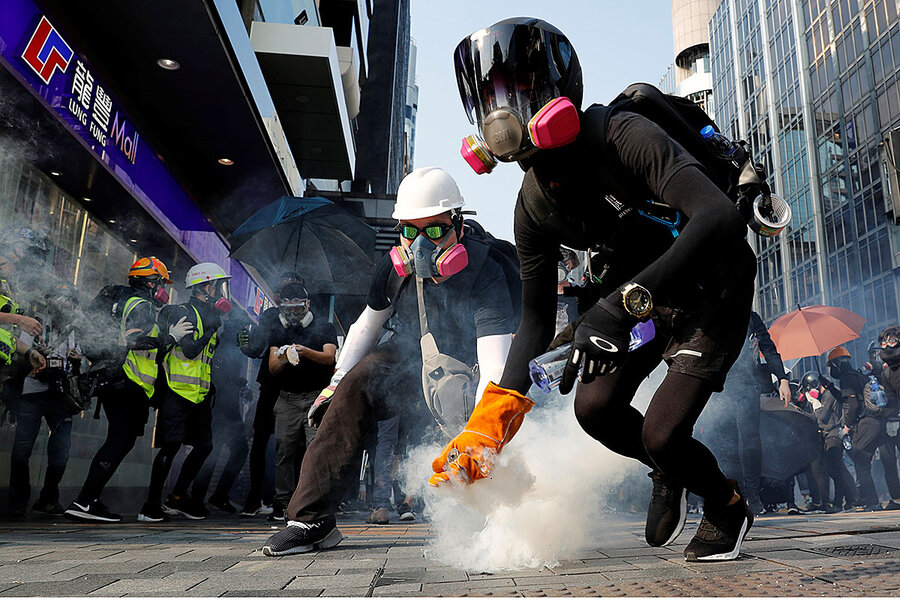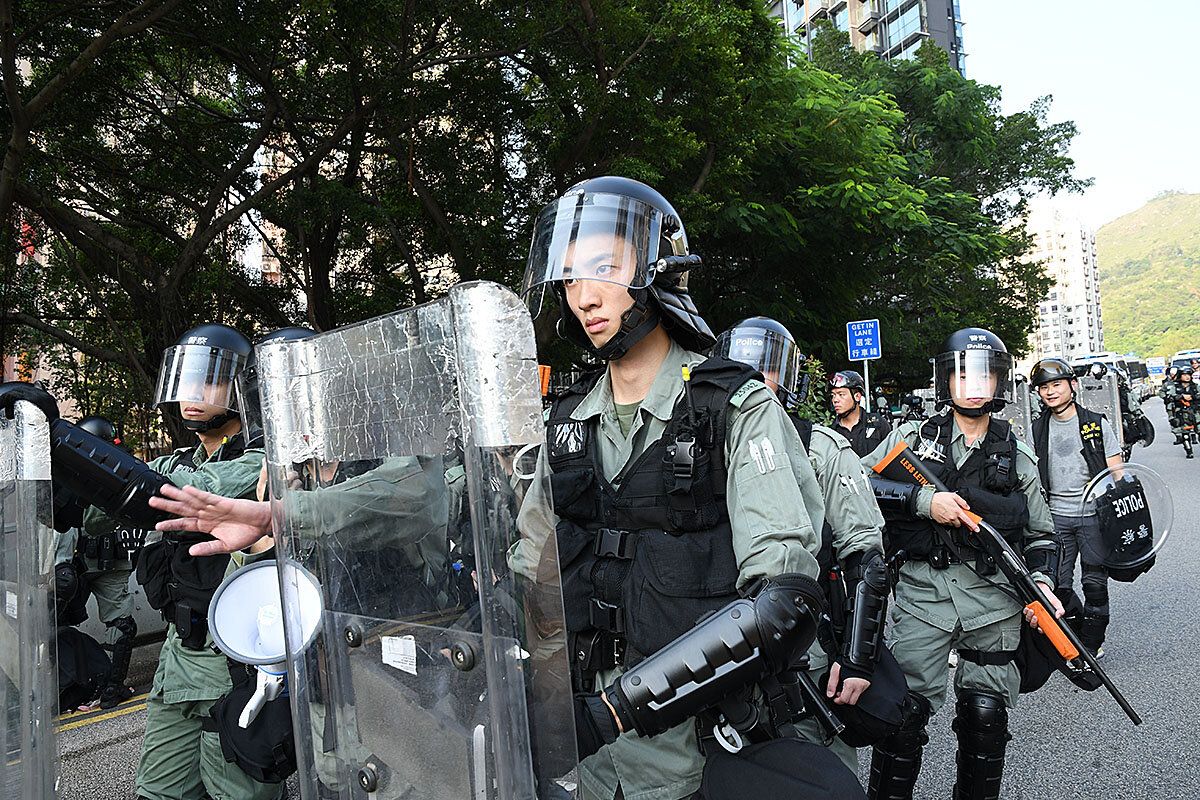Four months into protests, Hong Kongers’ distrust runs deep
Loading...
| Hong Kong
The last Sunday in September, one frustrated, anonymous person chose a traditional Chinese way of venting his frustrations in public. Taped to the glass wall of a rail station’s entrance hung 13 large sheets of newsprint covered in big, hand-drawn characters. They detailed the author’s claims that dozens of people had died suspiciously since protests began last spring.
Passersby stopped to read. A man parked his green bicycle. A woman snapped photos while a taxi driver halted in the traffic lane and craned his neck. Several murmured: Why had officials lowered the number of people injured in a subway station during a violent police clearance in August? Why wouldn’t the government release closed-circuit footage to show what happened? Why did riot officers bar medics and journalists from the scene?
For weeks, the government attempted to refute unfounded rumors that three people were killed by police in Prince Edward station. The conspiracy hatched after first responders revised the figures of those injured that night from 10 to seven. The MTR Corp., the rail company, said it was told that nine were reported injured. A logbook was accessed multiple times. Police and fire officials provided accounts, but their press conferences did not calm part of the public. The problem, these residents said, was that the government had no credibility in their eyes.
Why We Wrote This
When unfounded rumors gain steam, we often blame social media. But hearsay’s influence also points to deeper distrust of government, media, and institutions, all of which have fueled Hong Kong’s protests.
“There’s nothing we can do. Hong Kong is under complete control of China,” said one of the poster readers, a man who would identify himself only as Mr. Lau because of fears the government might pursue him. “That’s why everyone is so frustrated. We can’t change the future, no matter how much we hate it. ... Certainly the government tries to cover up the truth.”
Many Hong Kongers have been wary of Beijing for decades, stretching back to the bloody clearance near Tiananmen Square in 1989, which killed hundreds, perhaps thousands of people, and the government-imposed silence thereafter. In Hong Kong, as concerns grow about Beijing’s tightening control, many residents believe little of what the city’s chief executive or the police say. They view Hong Kong’s chief executive, Carrie Lam, as a puppet of Beijing. In her refusal to address many protesters’ demands, they see signs of a changing Hong Kong – a city that once claimed to be clean and transparent, now feeling more closed and threatening.
Asked in an October poll how much trust they have in police and local government, roughly half of residents said “zero.” Several other once-trusted agencies have fallen in public esteem in recent years: schools, the justice department, the hospitals. At one point, even weather service reports were questioned. Increasing wariness of local media, a sense that TV broadcasters and some news sites defer to mainland views, has added to societal unease.
Fears that Hong Kong’s autonomy is ebbing stoked the massive campaign convulsing the city today. The focus widened from stopping a bill to allow extraditions to mainland China to demands for greater democratic rights and controls on police. The deep distrust has shaped an environment in which many Hong Kongers disagree about not just their opinions, but the facts. The protests have divided younger residents from older ones, those seeking peace under Beijing from those who say they must stop the government from stripping their rights.
“People have taken their stance and people believe what they want to believe,” says lawmaker Fernando Cheung, a retired social work professor who has served in the legislature since 2004. “They’re not directed by rational thinking. They’re directed by their stance. It’s hard to keep rational when the whole society is completely polarized.”
An uneasy relationship
Before Britain relinquished Hong Kong in 1997, Beijing pledged it would have a high degree of autonomy until at least 2047, including its own constitution to protect residents’ rights. Yet trust in the “one country, two systems” idea started to erode even before the handover, pushing many families and young people to flee abroad.
Since then, the mainland government has intervened routinely. In 2003, locals pushed back against an anti-subversion law pushed by Beijing. Conflict has erupted regularly over the elections system, which does not allow voters to choose the city leader directly. In 2012, some 100,000 demonstrators rejected a local school curriculum that critics derided as Communist brainwashing.
Concerns have intensified since Chinese leader Xi Jinping came to power in 2012. Two years later, when Beijing backed a new elections system that would subject candidates to screening, it touched off a 79-day street occupation. In 2016, after some young Hong Kongers began to talk about independence and self-determination, Beijing issued an interpretation of the territory’s Basic Law that effectively ejected six lawmakers from office, leaving many young voters feeling disenfranchised.
Mistrust at times fanned strange rumors. Some netizens accused the Hong Kong Observatory in 2015 of failing to issue major typhoon warnings, blaming Li Ka-shing, the territory’s wealthiest resident, who some people believed pressured the government to issue lower signals to avoid economic hits.
Fear swelled the protest movement this spring. After months of anemic marches, university and alumni groups and some political parties warned that the proposed extradition law could send almost anyone to a Chinese prison – including businesspeople, churchgoers, and activists – and weaken legal walls between Hong Kong and the mainland. Many critics of the bill acknowledged that the government's likely goal was to curb corrupt business practices.
In June, an estimated 1 million people marched against the proposed amendment. When Chief Executive Lam stood by it, twice that many came out a week later. Only after her approval ratings plunged did she withdraw the bill. By then, many residents were enraged that the police had driven off crowds with a fusillade of tear gas and rubber bullets.
Mrs. Lam “is targeting, tearing Hong Kong people into two,” Millie, a young salesperson and protester, said in June – referring to young people, with more to lose in the future, and older residents, aiming to protect their business and property interests.
Police force fallout
By far the most reviled institution in the Hong Kong government is the police force. In June, days after the million-strong protest, police fired tear gas and rubber bullets at protesters near the government center. Videos of people being beaten with batons, temporarily blinded and bleeding, enraged the public. An estimated 2 million people filled city streets days later, elevating police tactics to one of the movement’s key concerns.
Tensions built throughout the summer. Police waited in emergency wards of public hospitals, questioning and even arresting some patients. After they were admitted, some of those injured said that police stayed with them inside their hospital rooms. A lawmaker revealed what he called a loophole in a data system that allowed police to access patients’ information, an accusation hospital authorities have denied. Doctors established a hotline to funnel frightened protesters to physicians who agreed to treat people but keep their identities and injuries confidential, says Alfred Yam-hong Wong, a cardiologist and member of the Medecins Inspires support group.
Au Yiu-kai, a retired surgeon who has volunteered to help protesters, says that while one teen was in surgery earlier this month – one of two young people shot by police – a team of riot police in full gear with helmets and shields entered the hospital. Dr. Au says he complained to the hospital authority. “I know there are still young people who are injured who dare not to go to the hospital authority or private specialists,” he says. “They just feel frightened. If they're exposed, they will be caught.”
After protests on Aug. 31, when public fury was at a peak, riot police stormed the Prince Edward subway station. Officers beat bystanders and tackled people, soaking some riders with pepper spray. Police defended their actions as an operation to arrest rioters. Officers barred medics and journalists from the station and, at one point, ordered a group of medical volunteers who tried to respond to stand facing a wall. When the station was kept closed for two days, the public’s suspicions raced.
Officials slightly changed the tally of injured people several times, and blamed the discrepancies on the chaos in the station. After people demanded that the transportation corporation release footage, it eventually shared about two dozen images. Police, hospital, subway, and fire authorities repeatedly said that no one was killed, as officials condemned the rumors.
Some citizens, though, continued to speculate that people died inside the station. The doubters shrouded a station entrance with white funeral flowers and burned incense. Protesters stood outside the nearby police station for hours, shouting “murderers” until riot officers fired tear gas at them.
Shifting media scene
For years, media-savvy residents here have navigated a daily tsunami of news, rumor, and speculation, with a great deal flowing from the Chinese Communist Party. (Over the summer, Twitter announced it had suspended thousands of accounts that it believed were part of a Chinese government campaign to sunder the protests.) Traditional news outlets have seen readership fall, replaced by upstart and often free news sites that sometimes carry weak reporting. The biggest broadcasters have been criticized for soft-pedaling news about Beijing, and residents worry about increasing self-censorship from other outlets as well. Even back in 2016, trust in local news groups had fallen to its lowest in a decade, with an overall credibility rating of 5.66 out of 10, according to a poll by the University of Hong Kong.
Meanwhile today, unverified or skewed accounts spread by partisan groups mix with wild rumors to flourish on social media feeds and channels. The disinformation phenomenon led one journalism professor to start a new fact-checking project that examines claims on social media and LIHKG, Hong Kong’s Reddit-like site.
“The scale of protest is bigger. The scale of violence is bigger. Therefore the volume of false information is bigger now, and it’s much harder to be discerning now,” says Masoto Kajimoto, assistant journalism professor at the University of Hong Kong. “The more polarizing the issues are, the more likely people fall for false stories or don’t care.”
Sometimes the problem isn’t false news, but interpretation. A video of a police officer who was beaten by a small group of protesters until he pulled his service revolver and shot one teen point-blank drew sharply different responses. Viewers sympathetic to the movement saw police brutality, Professor Kajimoto says, while police supporters saw violent rioters threatening an officer’s life. “It is not just selective editing,” he writes in an email. “People see what they want to see – that’s the real danger of this type of video. It confirms and reinforces our preconceived biases.”
As for the Prince Edward incident? “It is total nonsense,” he says. But the question is how to refute it. “If you say, ‘This is what people believe,’” you are part of the ecosystem trafficking in fake news.
Unsettled by the rumors and distrust, some civil society groups asked the Hong Kong Public Opinion Research Institute, a spinoff from the University of Hong Kong, to query the public. Pollsters asked whether respondents believed rumors about collusion between police and gangsters, or that Chinese forces had infiltrated the Hong Kong police. In both cases, with no solid proof, about two-thirds of the public said yes, according to Ed Tai, a statistician with the polling center who has reviewed the as yet unpublished results.
“These puzzles or these questions have stirred into rumors and leave even more unanswered questions,” he says. “The chase for democracy has been overtaken by the pursuit of the truth.”







